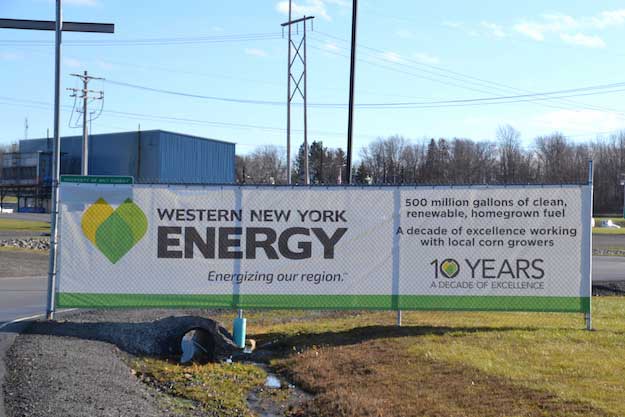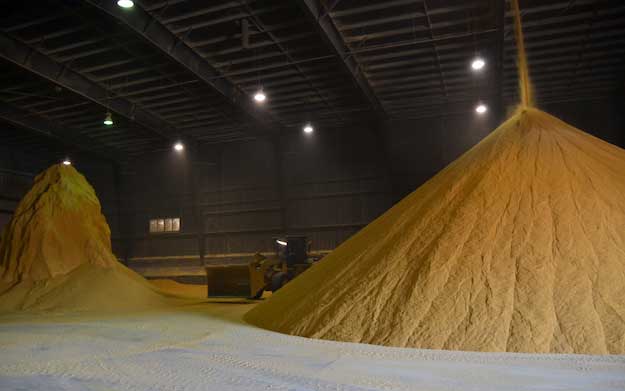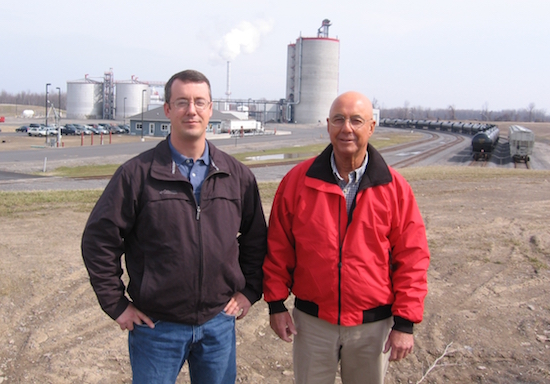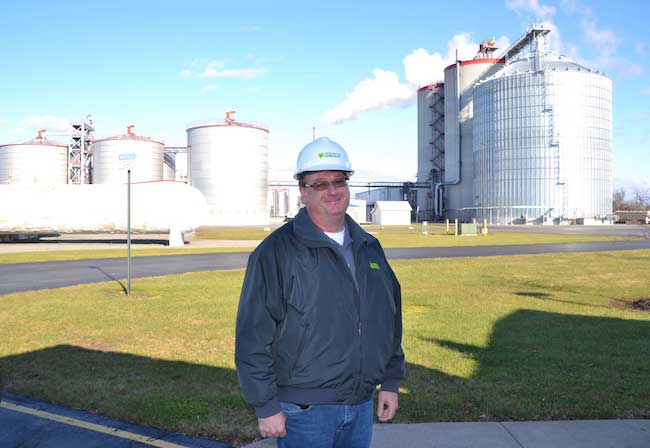Leader of ethanol plant says facility has been an asset to local farmers, community
MEDINA – Tim Winters, 48, is chief executive officer of Western New York Energy, a company that celebrated its 10th anniversary of production last week.
Winters joined the in September 2007, soon before it opened and began turning corn into ethanol. WNY Energy initially planned to use 20 million bushels of corn annually to produce 50 million gallons of ethanol.
The output proved a conservative number because the company is on pace to produce 62 million gallons this year. All of the ethanol is blended and used in the Rochester and Buffalo markets.
The facility also produces high-protein distiller’s grains for livestock and the CO2 is captured and used for food and soda industries. The company pays more than $1 million in taxes locally each year.
John Sawyer and his son Mike were influential in getting the plant built. John was the company’s first CEO and president. He died from leukemia at age 72 on Oct. 13, 2013. Mike followed his father as the company’s CEO and president. Mike died while hiking in the Adirondacks at age 43 due a medical condition on Aug. 18, 2016.
Tim Winters said the two Sawyers were critical in getting the plant built and in its success. Winters was interviewed on Friday at his office at WNY Energy, which is located at the corner of Bates Road and Maple Ridge Road.

A banner at the entrance of the plant notes that WNY Energy has produced more than 500 million gallons of ethanol in the past decade.
Question: What did you do at the start your career?
Answer: I was in the family business for several years and then had a couple different jobs. Then I moved out West for six years and worked for a large grain company in Oklahoma.
Question: Was that where you were right before Western New York Energy?
Answer: Yes.
Question: What did they do to lure you back home?
Answer: I was actually here getting remarried and was nosing around the company. The company I was with was talking with companies about building ethanol plants and grain elevators in Oklahoma. While I was back here I wondered what this new plant was all about. I ended up meeting Mike (Sawyer) and emailing Mike. He asked me what is it I do and I told him I was a controller. He said he was looking for a controller. It just kind of happened very quickly from there.
Question: What does a controller do?
Answer: A lot of everything. In a normal capacity it’s just accounting functions. But for us here at this company it’s a lot of dealing with some of the marketing, operational and working with the plant, helping to analyze data. I also do a fair amount of the IT. I have some grain experience so I was involved in that.
We’re a large company but it is small enough where I had the title of controller, but it was always whatever needed to be done.

A truck with grain from H & E Farms in Albion is unloaded last Friday at the ethanol plant.
Question: When you guys started I think you were taking in 20 million bushels to make 50 million gallons of ethanol. I thought the output ended up being more.
Answer: It was 50 million as the original name plate, that’s what the plant was designed for. We started running pretty much over that within months when we started.
Question: Was that because it was a conservative number?
Answer: They design these to be able to run a little bit harder. We were able to gain efficiencies and learn more about the plant to get more gallons out. It’s been pretty much a continuous trajectory up since then. Currently today we are running about 62 million gallons with a potential to run even higher.
Question: With 20 million bushels?
Answer: Yes. Twenty million is what we’ll grind this year. It will probably be 21 million next year. When we started we were probably grinding 17 to 18 million.
Question: That’s significant because I know one of the criticisms I’ve heard about ethanol is the amount of energy to produce it. You’ve made gains getting more out of the corn. It looks like you’re about 3 gallons for every bushel of corn.
Answer: A lot in the industry when it was started was about 2.7 to 2.75. Our average over the years I would say has been 2.9-plus. Every year you try to close in on that magic 3 number.
Question: Has it happened for you?
Answer: Not yet, but with the technology each year we’re getting a little bit closer.
Question: I wonder what could clinch it for you to hit the 3 level?
Answer: It doesn’t sound like a lot to go from 2.9 to a 3, but that’s actually a lot. For every hundredth that you get it’s a big step. It takes quite a bit to gain those little bits. When you think about it, take that .01 and multiply it by 20 million bushels. That’s a lot of gallons.
Question: (During the interview several trucks stop at the weigh station outside by Winters’ office) Is this a normal occurrence for you, having all of these trucks here?
Answer: Generally on average we take 75 a day.
Question: And that is throughout the year?
Answer: Yes. We have times in the year where there are more. It could be a hundred or more. We have unloaded as many as 200 corn trucks in a day in the past. Sometimes, it’s 40-50 a day. It really depends on how much is bought and the time of the year.
Question: In terms of the impact for the local farmers, they used to have to drive much farther, to Dunkirk perhaps to the Purina plant.
Answer: Or Arcade or Batavia.

Tim Winters keeps an eye on market prices at his office.
Question: When you’re driving farther, it can gobble up your day just with the added time.
Answer: Yes. An hour-and-a-half to 2-hour drive is not uncommon at all each way.
Question: With the local growers, including some in Medina, it must be awesome having you here so close by. And you can see all of the new grain bins that have been put up in the last 10 years, including the new one by Western New York Energy. (The WNY Energy bin can hold 800,000 bushels and was built about two years ago.) What was the reason for the new grain bin you added?
Answer: One of the big reasons we decided to do it was because as we continue to produce more, we needed to have more days of run time available. What if you got into a winter storm in the middle of January? With only a million bushels of storage, that was only around 15 to 17 days for us. That was kind of uncomfortable. So a larger capacity gives us that insurance if we have bad weather and at the same time gives us more options throughout the year. We can buy more during harvest than we could before.
Question: I think 50 people work here.
Answer: It’s 51 today. That includes Shelby Transportation.
Question: With that, you guys go get the corn? How does that work?
Answer: Yes. We get the corn and we also haul out some of the distiller’s. We do some other hauling as well.
Question: When you consider the distiller’s and the CO2, is there any waste here?
Answer: No. When we’re done there is nothing left of the corn kernel. We use every piece of it. We talked earlier about the gripe about using more energy than you’re making, but in reality in the most recent analysis it’s at least 2 to 1, sometimes 2 ½ to 1. For every energy unit we’re using, we’re creating that much more than what a gas refinery or oil refinery would be. They’re energy deficits.
The point I’m making is gaining all of those efficiencies and using all of your byproducts, you don’t have anything to burn off or waste to dispose of.
Question: I think there were more criticisms of the ethanol industry 15-20 years ago, but you don’t hear that much these days. Do you think ethanol has proven itself?
Answer: One of the great things about being in this industry is we are young, we are really just in the first 10 to 15 years of taking off. With the technology every day there is something new coming out. It’s really exciting to see what is could be coming down the pike.

Distiller’s grains are a byproduct of the ethanol process and are used to feed livestock including many cows in Western New York.
Question: I know some plants have doubled in size after they opened. Is that something that might happen here?
Answer: It’s something that we have considered, but it’s quite an investment. When you look at building capacity on that large of a scale, the cost per gallon is quite a bit higher than when we originally built the plant. It’s something you have to take a much harder look at because your payback is going to be much longer. We’ve chosen to take a more phased in approach. We built a new fermenter, we built some cooling capacity. We’ll continue to look at some of those projects maybe just building up in phases, rather than in one big lump sum. Not to say that could never happen, but right now the phased in approach is the best investment strategy for Western New York Energy.
Question: What kind of ripple effect do you think this plant has had on the farming community?
Answer: From what I remember, growing up in the family feed and grain business, yes it has had an impact. This area has always grown a lot of grain. Anybody who has lived here more than 20-30 years remembers that. There used to be a lot of government storage. There used to be a lot of excess storage and prices that the farmers received were very poor. I remember years that corn was maybe $1.50, $1.25 a bushel. Over the years that got tough for a family farm to stay in operation.
After we started – within months of after we started – farm families that I’ve known for all of my life, it wasn’t uncommon for some of them to come up to me in the grocery store and say, “Tim, we are so glad you and the plant are here because we were getting ready to sell the farm.”
Just look at the farms that have built bins, that have trucks. They are doing better to be able to make investments in new technologies and equipment. But farming is still farming. There are good years and there are bad years, but hopefully overall the averages are better than what it was.
Question: Not only are you here and the corn price is up, but the yields are also up. It seems like a good time to be a local corn grower.
Answer: Right now, if I put my farmer hat on, the price is not great. The Chicago Board of Trade today is trading around $3.50 (per bushel). That’s not great but it could be a lot worse.
There are farms out in the Midwest that are getting below $3 cash price.
Question: I thought you paid a little more than going rate?
Answer: There are a lot of factors that go into it. The term you’re looking for is basis. That’s the price, plus or minus whatever the Board is trading at. That really depends on the season and a lot of other market conditions. Sometimes it’s over. We have been under at times. But generally we’ve been paying over.
Question: Don’t you test the corn and based on the quality that affects the price?
Answer: Yes, there are several different quality factors that we evaluate for. For instance, if it is too high in moisture there is a small discount and a dockage that goes along with it. If there is too much foreign material, beeswings or weed seeds – things like that that aren’t corn – there are discounts for that. It’s all about quality, just like anything else.
Question: If it’s wetter than you want do you then have to dry it?
Answer: We don’t have a dryer. All we have are fans. We can take slightly wetter than we’re used to. But we can’t take 18 percent or even 17 percent (moisture). What ends up happening is if you take that wetter grain and put it in the middle somewhere, concrete or the bin, it will eventually rot. To store it for any amount of time it has to be 15.5 percent or below, preferably.

John Sawyer, right, and his son Mike Sawyer were the driving force in establishing Western New York Energy and the construction of the $90 million ethanol plant.
Question: The only sad part about this is that John and Mike Sawyer aren’t here today.
Answer: I agree.
Question: But they certainly brought an asset into the community. I like that the shareholders are local people. The plant has helped to bring some money into the community. If the farmers make money they often put it back in the community, including helping to fund the Extension Education Center and the new library in Albion.
Answer: Correct. That is one of things that drew me here. I didn’t know John or Mike before I came here. I checked them out and I’m sure they checked me out. I heard nothing but good.
When you heard John talk about where did this come from, it all came from his desire to help out farmers. This is what developed. It does allow us to provide not only 50 good-paying jobs for employees, but it allows us to do good things for the community – the Parade of Lights for example. As a Medina native, I’m very proud to do that. As you know, you’ve been in the area long enough, we’ve had a lot of things taken away over the years. It’s nice to bring something back for a change.





































































